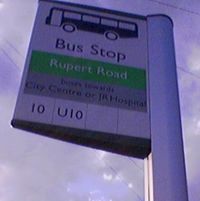Key:route_ref
| Description |
|---|
| Route reference (number/code) cognizable on public transport stop signs |
| Group: public transport |
| Used on these elements |
| Requires |
| Useful combination |
| Status: in use |
| Tools for this tag |
|
The key 'route_ref' is used on bus stops to list all bus lines that serve this stop. If a stop is served by several bus lines, all services are listed in the tag, separated by semicolon, e.g. route_ref=10;U10. The tag is added to the object tagged as highway=bus_stop or public_transport=platform. Currently (2018-03) about 6.5% of all platforms are tagged with their respective routes using this key.
It enumerates all the lines which serve that bus stop. It's data which can easily be gathered/checked during survey or which can be calculated when timetable data is present under a suitable license.
When the routes are not signed on the stop, this can be marked with route_ref:signed=no.
Combination with relations
Please note that there is a certain overlap with bus routes mapped as relations (see Relation:public_transport). It is not necessary to use both schemes for the same bus stop. route_ref=* can easily be added to individual bus stops without knowing the whole route a service takes. It can serve as a basis to add the full route relation later on. If the full route is known, using a relation should be preferred, as it provides more information and can be shown as a route on dedicated maps or can be used in routing engines.
In some localities, one cannot predict the order that bus stops are listed on a sign based on the route numbers themselves; some higher-numbered routes may arbitrarily be more important than lower-numbered routes. In these cases, route_ref=* is the only way to indicate the signposted order at a given stop, since a way does not indicate an intrinsic order to the relations of which it is a member.
Usage
It was originally used by NaPTAN/Tag_mappings import, but is now used all over the world. In Belgium, it is used on the bus and tram stops of MIVB/STIB.
Situation in Belgium
It became necessary to use a name spaced approach to enable using the same platform node for stops of different operators/networks.
- Also, in Belgium, at least, the route_ref tags remain on the stops after the itineraries are added as route relations. Some redundancy doesn't hurt and they can serve a purpose in validation tools.
Belgian operators
- De Lijn (Flanders and extending into Brussels and The Netherlands) was moved to
- TEC (Wallonia and extending into Brussels and Maastricht)
- MIVB/STIB (Brussels and extending to the airport in Zaventem) can simply go into
